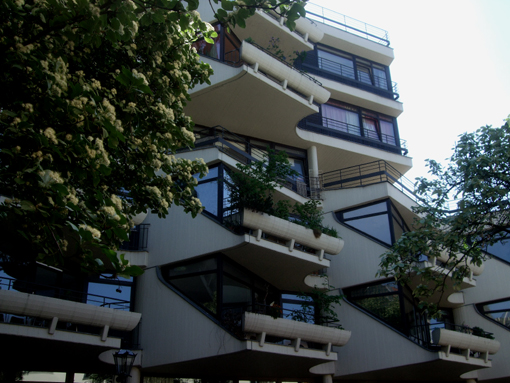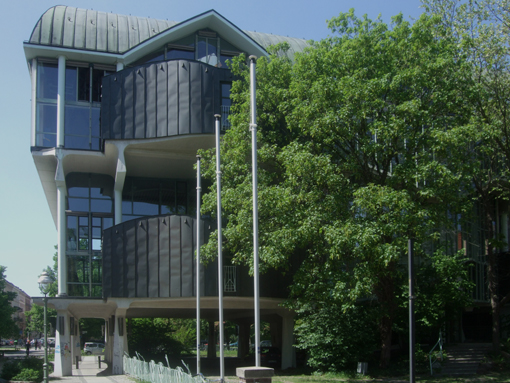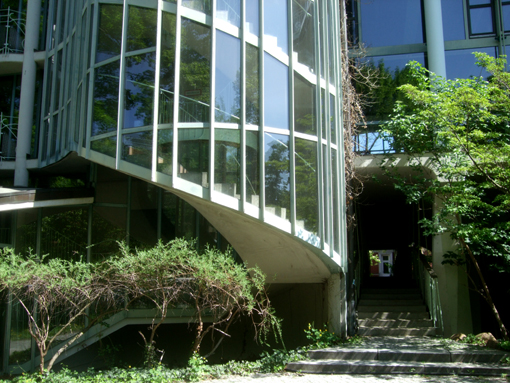excursion to buildings of
Hinrich and Inken Baller and to the Kantgaragen
social housing and gymnasium in Charlottenburg on May, 7th, 12:30 pm.
Because the number of participants is restricted, we kindly as for an immediate response.
We are sorry to announce that the scheduled tour, the second part to buildings of Ludwig Leo,
has to moved to another date, to a date in the week as well: It now will be on Thursday, the 12th, at 8:30 in the morning. This was the only possible time to enter the Gymnasium Charlottenburg.
More information >>> here.
meeting point is the bus station Luisenplatz / Schloss Charlottenburg (from Zoo: M45 direction Johannsistift, 11 min., from Ringbahn S Westend: bus M45 direction Zoologischer Garten, 5min.) at 12:30 pm. From there it's a 5 minutes walk to
the social housing in Nithackstraße, on the corner to Stallstraße. We will visit the house and at least one, hopefully even more flats. After this we'll walk down Nithackstraße to a next Baller house on the corner to Schustehrusstraße and from there to the gymnasium in Schlossstraße also of Baller and Baller. Unfortunatly the building is open just on weekdays, but for it is very open we'll get a good impression on how it works.
A fifteen minutes walk brings us to the Kantgaragen of Richard Paulick and Hermann Zweigenthal, on of the very few real Bauhaus buildings in Berlin, built in 1929-30.
The tour could end at the legendary Schwarzes Café, Kantstraße 148.
Social housing Nithakstraße
Built in 1977, it is one of the first houses of the Ballers. 35 units for social housing are housed, nearly each with two large balconies, plus roof gardens, underground parking and a garden.
Sporthalle Schlossstraße
more information in German
>>> here. and about the roof construction
>>> here.
It's built in 1988. The gymnasium consists of two sport fields on top of each other. THe ground floor is kept free for parking in a surprising comfortable way. All aditional rooms are boxes off the main volume.
Hinrich and Inken Baller
Hinrich Baller is a strange appearance in the Berlin architecture. His aesthetics are unique and always under discussion, but more than some see this problematic. But it's out of question, that he has a great talent in developping different, baroque-like plans and surprising spaces. He's influenced by Bruno Taut and Hans Scharoun.
He is born in 1936. He studied under Bernhard Hermkes (whom planed the Ernst-Reuter-Platz and the TU faculty of architecture and the famous Grossmarkt Hamburg).
Inken Baller was born in 1942 in Tondern, Danmark. They both worked together from 1967 to 1989. She now is professor in Weimar.
In 1979 both planned the masterplan and two houses for the documenta urbana in Kassel, in 1981 they built the philosophical institute of the FU Berlin, and for the IBA in 1984-85 their most famous buildings at Fraenkelufer in Kreuzberg.
Both are still active in building, Hinrich now works together with his second wife Doris.
Kantgaragen
The
Grossgaragenpalais Kantstraße was the first car garage in Berlin - and it still is in use as exactly that.It had room for 300 vehicles.
more in German plus historical images
Richard Paulick, born in 1903, studied at TU in Dresden and Berlin under HanS Poelzig, he was with Gropius at the Bauhaus in 1927-28. In Dessau he built the famous and first Steel House in 1925-26. He opened his own architectural offivce here in 1930, but as a political active socialist had to leave Germany in 1933 to Shanghai, where he worked as planner and later professor at the university and head of the city planning office. 1949 he left back to Germany, settled in East-Berlin, worked with Hans Scharoun and built the section C of the Stalinallee. He was than one of the heads of the reconstruction of the historical Berlin (for example Staatsoper, Prinzessinnenpalais and Kronprinzenpalais, all Unter den Linden) and of Dresden. After Stalins death he turned back to modernism. He was Professor and had a experimental office, later investigated in serial construction. He was leading architect of the planing and founding of the towns Hoyerswerda and Halle-Neustadt.
more on Richard Paulick in German.
Hermann Zweigenthal, born 1904 in Vienna, studied at TU Berlin under Poelzig as well. He made a study on all-encompassing parking for the republican German Car Club. He worked as stage designer in several Berlin theatres from 1923 to 1932, when he had to emigrate first to Switzerland, than England, and finally to the USA, where he gained reputation as urban planer under the name Hermann Herrey, and from the 50ties on in theatre as well. He built a house next to one of John Hejuk in Locust valley.
There is a tour on the following thursday to the
the Sporthalle Charlottenburg and to the former kinder garden Loschmidtstraße of Ludwig Leo,
on May, 12th, 8:30 am, early morning.
The tour is a cooperation of Büro Schwimmer and
architectureinberlin







